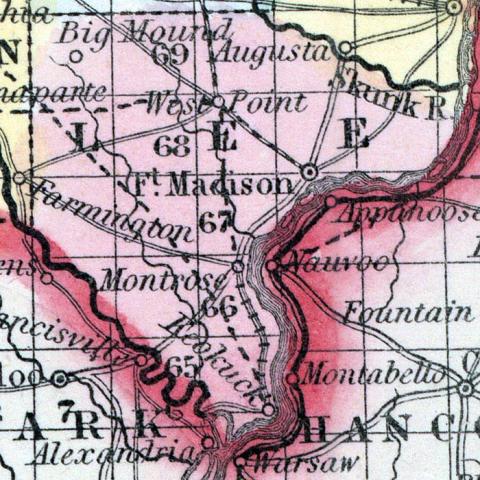LEE, a county forming the S. E. extremity of Iowa, bordering on Missouri and Illinois, has an area of 480 square miles. It is situated at the confluence of the Mississippi and Des Moines rivers, which respectively form the boundaries of the county on the S. E. and S. W.; the Skunk river forms its N. E. boundary; the county is also drained by Sugar and Halfbreed creeks. The surface is undulating, and presents an alternation of prairies and woodlands in convenient proportions. The soil is uniformly and highly productive. In 1850, Lee county produced a greater quantity of Indian corn, wheat, and butter than any other county in the state. There were raised 754,138 bushels of corn; 149,414 of wheat; 165,237 of oats; 13,810 of potatoes; 29,885 pounds of wool, and 232,225 pounds of butter. It contained 16 churches, 3 newspaper offices; 2402 pupils attending public schools, and 182 attending academies or other schools. The county contains extensive beds of stone coal and quarries of limestone. The streams afford permanent water-power. The state has undertaken to open steamboat navigation on the Des Moines river; and a company has been formed for the construction of a railroad from Keokuk to Dubuque. This county is the most populous and wealthy in the state. The Sacs and Foxes were removed from the soil about 1835. Keokuk and Fort Madison are the capitals. Population, 18,860. (Baldwin's New and Complete Gazetteer of the United States..., 1854)
LEE COUNTY Is situated at the junction of the Mississippi and the Des Moines Rivers, and is the most southern county in the state; it is bounded on the south-east by the Mississippi, which separates it from Illinois; on the south-west by the Des Moines, separating it from Missouri; on the west by Van Buren; and on the north by Henry and Des Moines counties. The county is well watered by the Des Moines and Mississippi and their tributaries. The principal towns are Keokuk, Montrose, Fort Madison, West Point, Franklin, Nashville, &c. The bottom-lands of Lee are well adapted to the wants of the agriculturist, and its prairies are elevated, dry and rolling. The business of stock-raising has been entered into in Lee more extensively perhaps than in any other county. (Iowa As It Is in 1855; A Gazetteer for Citizens..., 1855)

